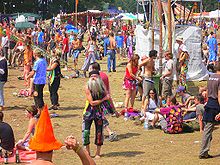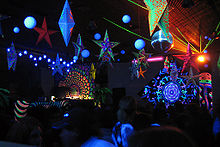- Psychedelic trance
-
Psychedelic trance Stylistic origins Goa trance - Trance - Space rock - Industrial - Acid house Cultural origins Mid-1990s, India (Goa), Israel, South Africa, UK Typical instruments Synthesizer - Drum machine - Sequencer - Sampler, Electric guitar Mainstream popularity Israel, Japan, Europe, Brazil, Mexico, Serbia Derivative forms Suomisaundi - Dark psytrance - Progressive Trance Subgenres Melodic psytrance - Progressive psytrance - Dark psytrance
(complete list)Fusion genres Psybient - Psybreaks Regional scenes Finland Psychedelic trance, psytrance or just psy is a form of electronic music characterized by hypnotic arrangements of synthetic rhythms and complex layered melodies created by high tempo riffs. It appeared in the mainstream in 1995 as with reporting of the trend of Goa trance. The genre offers variety in terms of mood, tempo, and style. Some examples include full on, dark, progressive, suomi, psybreaks and psybient. Goa Trance continued to develop alongside the sub genres.
Contents
History
Start of the movement
The first hippies who arrived in Goa, India in the mid 1960s were drawn there for many reasons, including the beaches, the low cost of living, the friendly locals, the Indian religious and spiritual practices and the readily available Indian hashish, which until the mid-70s was legal.
During the 1970s the first Goa DJs were generally playing psychedelic rock bands such the Grateful Dead, Pink Floyd and The Doors. In 1979 the beginnings of electronic dance music could occasionally be heard in Goa in the form of tracks by artists such as Kraftwerk but it wasn’t until 1983 that DJs Laurent and Fred Disko, closely followed by Goa Gil, began switching the Goa style over to electro-industrial/EBM which was now flooding out of Europe from Frontline Assembly, Front 242, Nitzer Ebb as well as Eurobeat.[1]
The tracks were remixed, removing the lyrics, looping the melodies and beats and generally manipulating the sounds in all manner of ways before the tracks were finally presented to the dancers as custom Goa-style mixes.[1]
Development
By 1992 the Goa trance scene had a pulse of its own, though the term 'Goa trance' didn’t become the name tag of the genre until around 1994. New artists were appearing from all over the world and it was in this year that the first Goa trance festivals began, including the Gaia Festival in France and the still-running VuuV festival in Germany.
In 1993 the first 100% Goa trance album was released, Project 2 Trance, featuring tracks by Man With No Name and Hallucinogen to name two. Goa trance enjoyed its commercial peak between 1996 and 1997 with media attention and some recognised names in the DJ scene joining the movement. This hype did not last long and once the attention had died down so did the music sales, resulting in the failure of record labels, promotion networks and also some artists. This ‘commercial death of Goa trance’ was marked musically by Matsuri Productions in 1997 with the release of the compilation Let it RIP.
Style
Psychedelic trance has a distinctive, speedy sound (generally between 140 and 150 BPM) that tends to be faster than other forms of trance or techno music. Psychedelic trance uses a very distinctive resonated bass beat that pounds constantly throughout the song and overlays the bass with varying rhythms drawn from funk music, techno, Middle Eastern music, and trance using drums and other synthesized instruments. The different leads, rhythms and beats generally change every 8 bars.[2] Layering is used to great effect in psychedelic trance, with new musical ideas being added at regular intervals, often every 4 to 8 bars. New layers will continue to be added until a climax is reached, and then the song will break down and start a new rhythmic pattern over the constant bass line. Psychedelic trance tracks tend to be 6–10 minutes long.[3] Psychedelic trance makes heavy use of the cutoff frequency control of the modulating filter on the synthesizer. Reverb and Delay are used heavily, with large, open sounding reverb present on most of the lead synthesizers in the track. The Roland TB-303 (acid) sequencer, Juno 106 and Roland SH-101 are heavily used and sampled in Psychedelic trance, usually processed through a distortion effect.
Related sub-genres
In 1996 the music had changed so much from its Goa beginnings that the term Goa trance no longer seemed suitable and the new term of psychedelic trance, or psytrance for short, was coined to refer to this new style of music. The multi-layered melodies of Goa trance were stripped away and a darker and more repetitive form of music concentrated on rhythm and groove appeared. A landmark album of this change would be the 1998 album Radio by X-Dream.
In 2002, melodies became popular again, heralding the beginning of full-on psytrance.
Currently, there are many sub-genres within the psytrance scene, including minimal/progressive psy, morning psy, full-on psy, and dark psy. There has recently been a movement attempting to ‘return to the source’ and bring back the original Goa trance sound, such as Metapsychic Records (2006 - December 2007)[4] and Suntrip Records, which are dedicated to reviving the roots of the scene and promoting artists trying to recapture the original feeling of the music.
Psybreaks
Psybreaks or psychedelic breakbeat is a form of psychedelic trance originating in the late 90s, splicing breakbeat basslines and rhythms into otherwise heavily psytrance-influenced tracks. Style typical Tracks: Drone - Pulsar, Morphonix - Island Sanctuary, and Planewalker - Spellbound.
Full on
Full on is a form of psychedelic trance that originated in Israel during the late 1990s. The expression “full on” is taken from the first out of a seven compilation albums series[5] and the first album ever to be released under Hom-mega Productions in 1998, titled Full On, which comes from English slang. Other sources say it comes from the "Full" "moon" festival's name, whilst others argue that it is derived from a phrase widely used to describe particularly high-energy music ("That tune is really full-on!"). It may also refer to the drug use sometimes witnessed ("full-on drugs") on the festivals, as this music is regarded "pushier" than other psytrance styles, thus more exhausting to dance to and the requirement of bodily stimulating drugs is more apparent.
The most easily recognizable element of full-on psy-trance is the so-called "rolling" bassline, which crams two or three short bass notes in between each hit of the 4/4 drum.
Some commercial morning artists associated with the following style:Sesto Sento, Gataka, 1200 Micrograms, Astrix, 40%, SOM and Vibe Tribe.
Some Full On Record labels: PsyShark, Phantasm Records, Hommega, B.N.E, and many more.
Dark
Main article: Dark psytranceDark psytrance (killer psytrance, dark psy, forest trance, fullon darkpsy) is a darker and faster form of psychedelic trance music, with tempo ranges generally from 145 to 180 BPM. Originating in Denmark, Russia and Germany, the style has recently[when?] expanded worldwide. Full on dark psytrance is a popular variation and can include melodies from morning trance. Some well-known dark psytrance labels include Parvati Records, Dark Prisma Records,Rumbling Earth Recs, Lamat Records, Ultratumba Records, Noise Poison records, Psynon Records and Demon Tea Records.
Progressive/minimal psychedelic trance
With a slower BPM range around 125 to 140, progressive psychedelic trance has a cleaner, crisper sound than other subgenres and is better known for well-constructed percussion underlying a complicated series or evolution of musically rooted melodies. At times uplifting, progressive psy has made a home for itself during the morning and daytime sets of many outdoor dance parties, particularly in the Australian doof scene, as well as worldwide. Zenon Records is the prominent label for Psygressive subgenre which is vastly different than the common Progressive trance.
Suomisaundi or freeform psytrance
Main article: SuomisaundiThis is the "freeform" variation of psytrance where the artist has almost no limits but still bear a specific "Finnish" style (which is also produced in other countries but the originating Suomi designation is in wide use).
Sources
Graham St John. (ed) 2010. The Local Scenes and Global Culture of Psytrance. London: Routledge.
References
- ^ a b Eugene ENRG (aka DJ Krusty) (2001). "Psychic Sonics: Tribadelic Dance Trance-formation - Eugene ENRG (aka DJ Krusty) interviews Ray Castle". In Graham St John. FreeNRG : notes from the edge of the dance floor. Altona, Victoria, Australia: Common Ground Pub.. p. 166. ISBN 1863350845. http://undergrowth.org/system/files/%5Beb06%5D_FreeNRG.pdf. Retrieved 28 March 2011.
- ^ Trance music. A definition of genre. Trance, goa, psy, house, progressive and more
- ^ Easwaran, Kenny. "Psytrance and the Spirituality of Electronics". April 2004.
- ^ http://www.discogs.com/label/Metapsychic%20Records
- ^ http://www.hommega.com/hommegaShop.php?curSubj=&artistID=&curPrdID=39&prdCat=compiletions
External links
- Psychedelic Trance at the Open Directory Project
- 21 psy trance visual demo videos (for countries where Youtube is blocked)
Psychedelic music Genres Acid blues · Acid breaks · Acid rock · Acid techno · Acid trance · Chillwave · Chopped and screwed · Freakbeat · Goa trance · Jam bands · Krautrock · Neo-psychedelia · New Age music · Paisley Underground · Psybient · Psychedelic folk · Psychedelic pop · Psychedelic rock · Psychedelic soul · Psychedelic trance · Space rock · Stoner metal/rock · Trip hopSubcultures Beat generation · Cannabis culture · Deadhead · Freak scene · Grebo · Hippies · New Age travellers · Rave culture · Second Summer of Love · UK undergroundSee also History of LSD · New age movement · Psychedelic · Psychedelic art · Psychedelic drug · Psychedelic era · Psychedelic literature · Rastafari · Sitar in popular music · Spiritual use of cannabis · Timeline of progressive rock · 420 (cannabis culture)Category:Drug culture · Category:Hippie movement · Category:Psychedelic musical groups Other electronic music genres Trance Other electronic music genres Categories:- Goa trance music
- Psychedelic trance
- Trance genres
Wikimedia Foundation. 2010.


